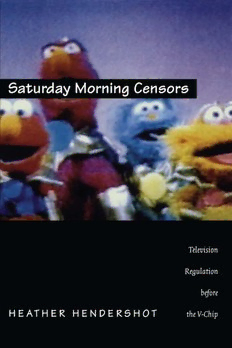
Saturday Morning Censors: Television Regulation Before the V-Chip PDF
Preview Saturday Morning Censors: Television Regulation Before the V-Chip
Saturday Morning Censors CONSOLE-ING PASSIONS Television and Cultural Power A series edited by Lynn Spi,gel Saturday Morning Censors Television Regulation before the V-Chip HEATHER HENDERSHOT Duke University Press Durham and London 1998 @ 1998 Duke University Press All rights reserved Printed in the United States of America on acid-free paper @I Typeset in Quadraat by Tseng Information Systems, Inc. Library of Congress Cataloging-in-Publication Data appear on the last printed page of this book. Contents Acknowledgments vii Introduction: Adults, Children, and Censorship I 1 Attacking (TV?) Violence 13 2 "We Call Our Company Motel": Looking for Sexism and Racism in the Children's Entertainment Industry 35 Action for (and against) Children's Television: "Militant Mothers" and the Tactics of Television Reform 61 4 Toys, TV, and Toaster Pictures: Children's Entertainment and the Free Market Mentality 95 5 Turned-on Toddlers and Space Age TV: Debating Sesame Street 137 6 Sesame Street Technologies: The Quest for Cultural and Scientific Neutrality 161 7 Hey, Hey, Hey, It's "Good" TV: Fat Albert, CBS, and Dr. William H. Cosby 193 Conclusion: Talking across Boundaries? 217 Notes 223 Bibliography 261 Index 275 Acknowledgments Many people and institutions helped me research and write this book. The staff of the University of Rochester Interlibrary Loan Department found in numerable books and articles for me, and archivists and librarians at other institutions were also helpful above and beyond the call of duty. Thanks to the staffs of the Action for Children's Television Archive at Harvard Univer sity's Gutman Library, the Margaret Herrick and American Film Institute Libraries in Los Angeles, the University of California, Los Angeles, Film and Television Archive, the Museum of Television and Radio in New York, and the University of Massachusetts Special Collections. At the University of Rochester, Nancy Hall, Rosemary Hattman, Patty Neill, Lucy Peck, and Cindy Warner helped me endure the daily trials and red tape as the book was initially taking shape. Thanks are also due to the Susan B. Anthony Center for Women's Studies, which provided fund ing on numerous occasions. Michelle BaIze, Jeanette Delamoir, Amanda Howell, and Anna Williams carefully read early drafts of several chapters. Over the years, Mark Betz's relentless acumen has contributed crucially to my own intellectual development. Jan-Christopher Horak was always a scrupulous and helpful reader, D. N. Rodowick offered professional savoir faire, and Constance Penley provided professional support and several fine meals that linger in memory. I thank Lisa Cartwright for reading closely and giving advice and encouragement. At Vassar College, the Henry Luce Foundation provided funding for a year of teaching and book revisions. Sarah Kozloff, Bill Hoynes, and Jim Steerman were all supportive Vassar colleagues. Thanks also to Marsha Kinder for her feedback and to Henry Jenkins for his valuable help with the manuscript and his ongoing support. When I was at wit's end, a number of students sustained my energy and made me feel like my teaching and research really mattered. I extend my gratitude to Jay Bartow, Jamie Bradshaw, Dante Bruno, Michelle Eden, Caroline Hanni, Kevin Maher, Sheila Murphy, and Rob Sosin, among many others. lowe a particular debt to the students in my Hampshire College classes on media censorship and animation history and aesthetics. The viii Acknowledgments Paper Tiger Television collective also played a crucial role in reinvigorating my interest in this project. In my salad days, Joyce Ackermann taught me how to read books. Lew Hendershot inspired an early interest in the pleasures of movies and cartoons; Peggy Hendershot and Ethel Gallagher enabled a healthy ge netic disposition to writerly stubbornness. Special thanks are due to Eric Smoodin, a good friend who spurred me on and had confidence in my work, even at its earliest and most tenuous stage. Myrtle was the best e mail pal a girl could ask for; Siobhan supplied the necessary tarts and roasts; and Lynn helped me wig out. Finally, I thank John Palattella. His companionship, perspicacity, and eggplant parmigiana provided suste nance. Introduction Adults, Children, and Censorship Debates on censorship invariably see it as a prohibitive process. assuming that a censored text. by distorting "reality" or in some other sense falling short of it. is in some sense partial in its representation .... This view is grounded in a distinction between a "rea\" world of social action on the one hand. and texts and represen tations on the other. It assumes. moreover, that the "real" constitutes a kind of self-evident truth. a truth that should -or in certain circumstances should not be reflected in representations; and that censorship stands. rightly or wrongly. in the way of this process of reflection.-Annette Kuhn. Cinema. Censorship. Sexuality. 1909-19251 Censorship is usually understood as prohibition: censorship forbids, ob structs, denies vision. It functions like a blindfold or a pair of scissors. This conception of censorship is misleading. In actuality, censorship does not just cut out images, sounds, or texts whose politics censors object to. The act of censorship is a social process through which the politics of class, race, gender, violence, and other potentially "problematic" issues are de constructed and reconstructed, articulated and scotomized. Censorship is a social process that both prohibits and produces meanings. Feminist film scholars Annette Kuhn and Lea Jacobs have shown, for ex ample, that censorship does not simply eliminate genres censors object to. Some generic conventions (indeed, entire genres) owe their existence to censorship as a social force. In her study of early twentieth-century British cinema, Kuhn explains that "the union of cinema and [censorious] pub lic morality ... produced a new cinematic genre," the propaganda film.2
